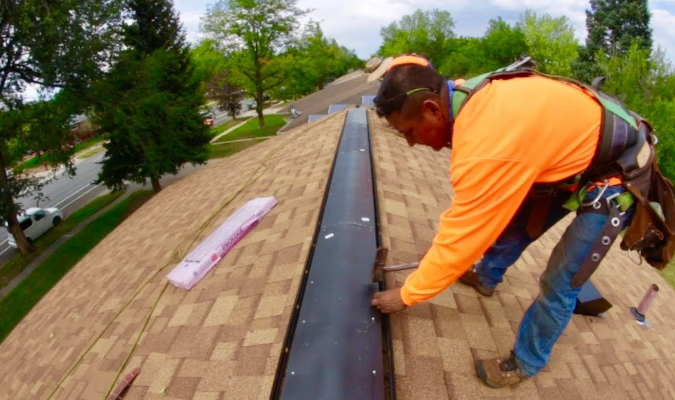Cost-Effective Roof Repair Solutions for Homeowners
Discover affordable and efficient ways to address roof repairs for your home.
Common Roof Repair Issues
Roof leaks are a common issue that homeowners face. They can be caused by damaged or missing shingles, cracked flashing, or deteriorated sealant. It's important to address these leaks promptly to prevent further damage to your home's interior.
Another common roof repair issue is sagging or uneven roof surfaces. This can be caused by structural issues or excessive weight on the roof. It's crucial to address this issue as soon as possible to prevent further damage to the roof structure.
Roof punctures and holes are another common problem. They can be caused by falling branches, hail, or foot traffic on the roof. These should be repaired promptly to prevent water damage and other issues.
Additionally, roof ventilation problems can lead to issues such as excessive heat in the attic, which can cause damage to the roof and increase energy costs. It's important to ensure proper ventilation to maintain the integrity of your roof.
Lastly, aging roofs may require repairs due to general wear and tear over time. Regular roof inspections can help identify any issues and address them before they become major problems.
DIY Roof Repair Tips
While some roof repairs are best left to professionals, there are certain tasks that homeowners can tackle themselves to save money. Here are some DIY roof repair tips:
- Replace damaged or missing shingles: This can be done by carefully removing the old shingle and installing a new one in its place. It's important to follow proper installation guidelines and use the right materials.
- Fix minor leaks: Small leaks can often be patched using roofing cement or sealant. Clean the area thoroughly, apply the patching material, and ensure it is properly sealed.
- Clear debris from gutters and roof: Regularly cleaning gutters and removing debris from the roof can help prevent water damage and prolong the life of your roof.
- Trim overhanging tree branches: Tree branches that hang over the roof can cause damage during storms or by rubbing against the roof surface. Trim them back to prevent potential issues.
- Check and repair flashing: Flashing around chimneys, vents, and skylights can deteriorate over time. Inspect it regularly and replace or repair any damaged or missing flashing.
It's important to note that DIY roof repairs should only be attempted if you have the necessary skills, tools, and safety equipment. If in doubt, it's best to consult a professional.
Hiring Professional Roofing Contractors
For more complex roof repairs or if you're not comfortable tackling the job yourself, it's advisable to hire a professional roofing contractor. Here are some reasons why hiring a professional is a good idea:
- Expertise and experience: Professional roofers have the knowledge and experience to identify and address a wide range of roof issues. They can provide accurate assessments and offer the most appropriate solutions.
- Safety: Roof repairs can be dangerous, especially for those without proper training and equipment. Professional roofers are trained to work safely at heights and have the necessary safety gear.
- Quality workmanship: Professional roofers have access to high-quality materials and know how to install them correctly. This ensures that the repairs will be durable and long-lasting.
- Time and cost savings: Hiring a professional can save you time and money in the long run. They can complete the repairs efficiently, preventing further damage and costly repairs down the line.
When hiring a roofing contractor, be sure to do your research and choose a reputable company with positive reviews and proper licensing and insurance.
Cost-Effective Roofing Materials
Choosing cost-effective roofing materials can help you save money on both the initial installation and long-term maintenance. Here are some options to consider:
- Asphalt shingles: Asphalt shingles are a popular and affordable choice for residential roofs. They are durable, easy to install, and come in a variety of styles and colors.
- Metal roofing: While metal roofing may have a higher upfront cost, it is extremely durable and can last for several decades. It also provides excellent energy efficiency, which can lead to long-term savings on energy bills.
- Composite roofing: Composite roofing materials, such as composite shingles or tiles, offer a balance between affordability and durability. They can mimic the look of other materials, such as wood or slate, at a lower cost.
- Rubber roofing: Rubber roofing is a cost-effective option for flat or low-slope roofs. It is lightweight, easy to install, and provides good durability and weather resistance.
It's important to consider factors such as climate, aesthetics, and the specific needs of your home when choosing roofing materials. Consulting with a roofing professional can help you make an informed decision.
Regular Roof Maintenance Practices
Regular roof maintenance is key to preventing major repairs and prolonging the life of your roof. Here are some important maintenance practices to follow:
- Schedule regular inspections: Have your roof inspected by a professional at least once a year, and after major weather events. They can identify any issues early on and recommend necessary repairs.
- Keep gutters clean: Clean your gutters regularly to prevent clogs and water backup, which can lead to roof damage and leaks.
- Trim overhanging branches: Trim back tree branches that hang over your roof to prevent damage from falling branches and rubbing against the roof surface.
- Remove debris: Regularly remove leaves, twigs, and other debris from the roof surface to prevent moisture buildup and potential damage.
- Check for signs of damage: Inspect your roof for signs of damage, such as cracked or missing shingles, loose flashing, or damaged sealant. Address any issues promptly to prevent further damage.
By following these maintenance practices, you can catch and address minor issues before they become major problems, saving you time and money in the long run.


